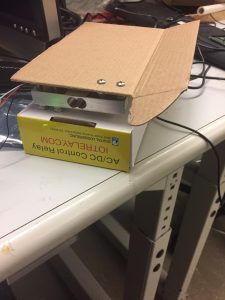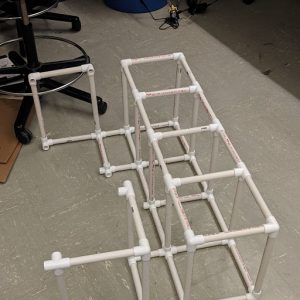Bill:
I built a makeshift platform out of cardboard.

Then I tested to see if it could detect an empty cup. For this, I just used an empty small size Starbucks cup. Using the Arduino, when I placed the cup on the platform, I was able to detect the cup. Then I hooked up the Arduino to the Raspberry Pi, and had the Arduino and the Pi communicate with each other using a serial USB connection. It was fairly simple, and I managed to get the Pi to read from the load cell.
Next week, I will start working on the functionality of only allowing the system to pour drinks when a cup is on the platform. Also, I will construct the platform so that liquids can pour through it into a basin.
Connor:
This week, I was able to finish most of the scaffolding. Tomorrow, it will be completed once we hang the valve and mixing station. However, here is a picture of the scaffolding in its current state:

Today, I purchased the adapters that were needed for the valve and the wire and fasteners that are needed to hang the valve and the mixing station. With that said, I attached the silicone tubing to the adapters that we hooked onto the valve, and we were able to pump water through the valve without any major issue. Now it’s a matter of stabilizing the valve as it receives liquids from the mixing station.

For the next week, I will be working on getting the scaffolding set up with the hanging mixing station and the valve. This work will mainly be done tomorrow, as our mid-semester demo is Monday. After our mid-semester demo, I am going to begin working on the API which will be hosted in AWS.
David:
I was working on connecting the Arduino with the Raspberry Pi, so that we would be able to control the relay with from the RPi through Arduino. Also, we would need to read the data from the load cell to the Raspberry too, so that we can control the pumps to pump liquid when the load cell senses a glass.
We worked on the scaffolding of the system and testing out the pump system for the mid-semester demo.
I also worked on the design of the software systems, specifically on the database and drink recommendation system.
For next week, I would need to start implementing the drink recommendation system besides preparing for mid-semester demo.
Overall:
We are in a good position for the mid-semester demo this upcoming Monday. We have everything from a physical standpoint that we need for Monday. We have also made substantial progress on the load cell grate reading from it and being able to determine it’s sensitivity, which seems fine. For tomorrow, it will be a matter of wiring up the various components (Raspberry Pi/Arduino to the pumps, valve and load cell) and writing any necessary software to ensure that the hardware works correctly. We have tested the pumps and the valve, and they have worked as expected. Hanging the valve and the mixing station might be a little tricky, but we made sure we bought enough metal rope for us to test with (various lengths and so forth). After the mid-semester demo, we do need to get started right away with a focus on the software portion, mainly the API and Raspberry Pi recipe-making capabilities. While we might be a little behind, we believe that we should also be fine on that front. With the software, there won’t be any waiting for parts or limitations due to budgets. We can move much more quickly on that front and, as a group, have more expertise in software than hardware.

